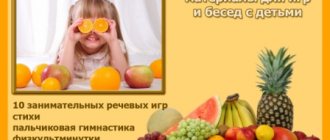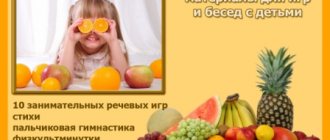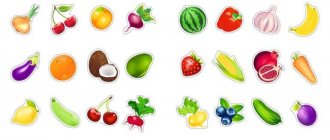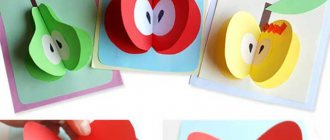Paintings on the theme “Fruit”
Ilya Efimovich Repin “Apples and Leaves”
We all know Ilya Efimovich Repin as a master of portraiture and a master of large canvases on mythological and historical themes (for example, the painting “Barge Haulers on the Volga,” which we discussed in the topic “Professions”). Still life was not the artist’s main genre, and we can say that the painting “Apples and Leaves” was created by accident. The still life, combining fruits and leaves, was created and staged by Repin for his student, young V.A. Serova. But the teacher liked the composition so much that he decided to paint such a still life himself.
A completely simple plot: six apples from the garden and a heap of leaves, but it’s all so native, Russian, realistic. The yellowish-green and red apples are not depicted as ideal “waxy” fruits, but as real, living fruits should look. It is felt that they have irregularities, dents and small spots. The simplicity of the painting makes the canvas a masterpiece worthy of the world's best halls and exhibitions.
Ilya Efimovich Repin loved nature very much. He lived 86 years and until his old age he slept in the cold, swam in the sea, never spent a day without gymnastics and ate a lot of vegetables and fruits. If Repin had a break from drawing, he found other activities for himself - riding a horse, swimming, working in the garden, planting plants or clearing snow in winter. And he did not hesitate to offer shovels to his guests, for example, Chukovsky, Mayakovsky or Chaliapin. Proper nutrition, physical activity, favorite work and the ability to live simply (without frills) are the main secrets of the longevity of the great artist. As in the painting “Apples and Leaves,” beauty is in simplicity.
Paul Cezanne "Still life with drapery, jug and fruit bowl"
Summary of a lesson on cognitive development in the second junior group on the topic “Fruits”
Abstract of educational activities in the 2nd junior group on cognitive development on the topic “Fruits”
Purpose: To introduce children to the fruits of fruit trees.
Reinforce knowledge that fruits grow in the garden. Progress of GCD
Educator: The guys have gathered in a circle, I am your friend and you are my friend. Let’s hold hands and smile at each other! (There is a knock on the door and the postman brings a letter)
.
Educator: Children, look, this letter was sent to us from the magic garden. (The teacher reads a letter from Grandma Masha: “Dear children, come to us soon! We have grown a lot of fruit this year, and we do not have time to collect and process them! Thank you!”)
.
Educator: Children, do you agree to go to the magic garden and help Grandma Masha? Children: Yes!!! Educator: Then let's hit the road! We walk along the path, singing songs together! And today we are all together, Let's go to the fruit garden! Educator: Here we are! Look who's greeting us? Children: This is Grandma Masha! Grandma Masha: Hello my dear guys! Children: Hello! Grandma Masha: I am very glad that you came to me. Will you help me harvest my big fruit harvest? Children: Of course. Grandma Masha: Well then, go ahead. Now I will ask you riddles about the fruits that we will now collect! Round, ruddy, I grow on a branch. Adults and little children love me. Children: This is an apple! Grandma Masha: Correct! This Apple! Now we will pick apples! (Children collect apples in a basket)
.
Educator: Children, what can you make from apples? Children: Juice, Jam. Grandma Masha: Well done kids, we dealt with you very quickly! Now listen to the next riddle! The fruit looks like a tumbler and wears a yellow shirt. Having broken the silence in the garden, it fell from the tree... Children: Pear!!! (Children collect pears)
.
Baba Masha: What great fellows you are! Listen to the next riddle! Blue uniform, Yellow lining, Sweet in the middle. Children: This is a plum! (Children collect plums)
.
Grandma Masha: Well done! Today we collected a lot of fruit! What can you make from these fruits? Children: Make jam, cook a pie, cook compote. Grandma Masha: And now we will play the game “Cooking Compote” . We will cook compote. You need a lot of fruit, that's it. We will chop the apples, we will chop the pear, we will squeeze out the lemon juice, we will add the drain and sand, we will cook, we will cook the compote, we will treat the honest people. (Children put fruits in a pan according to the text)
.
Educator: What great fellows you are! Helped us harvest the harvest and make a delicious compote from it! Now it's time for us to head back to the group. We walk along the path, singing songs together! And now we are all together, Let's get into our group! Educator: Here we are back. Children, tell us where we went today and what we did there? Children: Children's answers.
We recommend watching:
Synopsis of GCD in the second junior group Synopsis of an open music lesson for children of the 2nd junior group Synopsis of a game lesson on search and research activities with children of the 2nd junior group Synopsis of a lesson in the 2nd junior group
Similar articles:
Summary of lessons in kindergarten in the 2nd junior group. Group room
Summary of a lesson in the junior group of kindergarten on the topic: “Human nutrition”
Lesson notes about kindergarten. Junior group
Music on the theme "Fruit"
Karen Khachaturyan "Cipollino - Prince Lemon"
The middle of the 20th century can be called, without exaggeration, the “golden age” of Russian animation. The artists carefully worked out every stroke, the cartoons were voiced by first-class actors, and great attention was paid to music. The music was bright, memorable, imaginative, capable of capturing a child’s imagination.
For example, remember the wonderful cartoon “Chippolino”, created at the Soyuzmultfilm studio by director B.P. Dezhkin in 1961. I still remember the bright musical compositions that sounded in the cartoon. The music for this cartoon was written by the great Soviet composer Karen Khachaturyan. 13 years later, based on this music, Karen Khachaturian created a children's ballet of the same name.
According to the composer, Gianni Rodari’s fairy tale captivated him so much that its characters lived in his imagination for a long time. “I couldn’t forget the cheerful Cipollino, the gentle Radish, the noble Cherry, the evil, loud Lemon... And for some reason, each hero now appeared to me in a dance,” admitted Karen Surenovich. Thus was born the idea of a ballet, which was embodied in a complete work in 1974. The choreography for the ballet was composed by choreographer Genrikh Mayorov.
The fate of the ballet was brilliant from the very beginning. The composer became famous throughout the world, and the ballet itself became one of the best in contemporary art aimed at children. The main roles in the ballet were performed by such famous dancers as Maris Liepa, Nikolai Tsiskaridze, Nina Sorokina, Marina Kondratieva and many others.
Some information about Karen Khachaturyan. He was born in Moscow into the family of a theater director. In 1949, Karen graduated from the Moscow Conservatory. His teachers and mentors included Dmitri Shostakovich, Sergei Prokofiev and Igor Stravinsky. Shostakovich emphasized Karen Khachaturian’s “depth of thought, masterly development of material, perfection of its implementation, beautifully flowing melodies, amazing sounds.” Karen Khachaturian composed music for symphony and small orchestras, for violin, cello and piano. Wrote five symphonies. Since 1950, Karen Khachaturian has written music for films and cartoons. The most famous of them were: music for “Cipollino” and for the film “Viy” with Natalya Varleya. In 1981 he was awarded the title of People's Artist of the RSFSR.
We invite you to watch the wonderful cartoon “Chippolino” with your children. And discuss many of the topics raised in the cartoon: mutual assistance, courage, inequality. Well, and, of course, find heroes who belong to vegetables. And the music, of course, listen more carefully to the music written by Karen Khachaturyan.
Summary of GCD in the junior group “Getting to know fruits”
Abstract of the educational activity “Getting to know fruits”
Tasks:
Give an idea of 3-4 fruits (apple, lemon, orange or tangerine). Learn to distinguish fruits by name, shape, color, surface, taste and smell. Develop sensory sensations, feel the joy of perceiving beautiful fruits and their smell. Communicate that fruits, like green onions, are very healthy, especially in winter.
Material.
Grandfather doll, basket with 2-3 green apples, lemons, oranges in a vase, napkin, cutting board, knife, plate, toy telephone.
Progress:
The teacher sits the children in a semicircle. On the table in front of them is a vase of citrus fruits, covered with a napkin. He informs the children that now they will have a “delicious” activity, expresses regret that there is no Grandfather, who not only has vegetables growing in his garden, but also has an orchard. Suddenly the teacher says: “Perhaps I’ll call Grandfather, invite him to us - let him come to class.” The teacher puts the toy phone on the table, “dials” the number: “Hello, is this a fairy tale? Please call Grandfather, who grew the turnip. Hello, grandfather, come to our lesson, the children are bored, they are waiting. We will now look at the fruits, and you also have fruits growing in your garden - you will tell us.”
While waiting for Grandfather, the teacher and children look first at the lemon, then at the orange. Children touch fruits, stroke them, hold them in their hands. With the help of an adult, determine the shape, color, surface (uneven but smooth), and note their differences. He gives everyone a lemon and an orange to smell and teaches them to enjoy the sight and smell of the fruit.
Grandfather “comes” with a basket containing apples. The teacher greets him and asks the children to greet the guest. He informs Grandfather that the children are observing onions, drawing them, and after the lesson they will show their beds. Now they will demonstrate how onions grow.
The teacher conducts a physical education session (the children depict how an onion grows several times).
Then the teacher shows Grandfather the fruits in the vase and invites the children to name them. He asks: “Grandfather, do you have such fruits growing in your garden?” Having received a negative answer, he informs the children that oranges and lemons grow only in southern countries - where there is a lot of warmth and sun, there is no snow. Invites Grandfather to smell the southern fruits. Then Grandfather says that he brought fruits from his garden, shows them (but does not name them). Asks the children if they know what it is. The teacher and children examine the apples (shape, color, smooth, shiny skin, pits on top and bottom, branches that are not found on citrus fruits). They smell apples - they smell very good, but in a different way, not like lemon and orange.
At the end of the lesson, the teacher cuts the apples, divides the citrus fruits into slices and gives everyone a try, notes the sweetness of the apple, orange, and the acidity of the lemon (Grandfather also treats him). If there is time left, he organizes the game “Guess by Taste” (the game can be played in the evening of the same day). After the lesson, the teacher and children show Grandfather the beds with onions - he is surprised and praises the children.
"Description of Fruit"
Children: The apple is red, round in shape. The apple is big.
2.With orange skin,
Looks like a ball
But the center is not empty,
And juicy and tasty. (Orange)
(There is a picture of an orange on the board).
Educator: What is this? What color is the orange? What shape? What size? Do you think an orange is sweet or sour?
Children: Orange, round in shape...
3.It's almost like an orange
Thick skinned, juicy,
There is only one drawback -
Very, very sour (lemon)
(there is a picture of a lemon on the board).
Educator: What is this? What color is lemon? What shape is it? What size is a lemon?
Children: answer questions
4.Blue uniform, white lining,
It's sweet in the middle. (Plum.)
(on the board there is a picture of a plum).
Educator: What is this? What color is plum? What shape? What size is the plum?
Children: answer questions
5. A whole herd of horses on one leash. (Grape.)
Educator: What is this? What color are grapes? What shape? What size are the grapes?
Children: answer questions
Educator: I’m sitting on a tree, round like a ball,
Red as blood, sweet as honey. (Cherry.)
Educator: What is this? What color are cherries? What shape? What size is the cherry?
Children: Cherry is red, round in shape. Small cherry.
Educator: Well done, guys. All the riddles were solved.
Educator: Guys, how can you call an apple, orange, lemon in one word? What is this? Children: fruit.
Educator: Guys, where do fruits grow?
Children: in the trees
Educator: What are the names of the trees on which fruits grow?
Children: fruit
Educator: Where do fruit trees grow?
Children: in the garden.
Educator: What is the name of a garden in which there are many fruit trees?
Children: orchard
Educator: Well done! The Hedgehog and the Little Fox are also happy with you.
Physical school
Educator: Let's rest a little. Leave the tables and come to me. Stand in a circle. And we will put the Hedgehog and the Little Fox in the center of the circle.
Children: Go out to the teacher’s carpet and stand in a circle.
“Yesterday we walked in the garden, They walk in a circle, holding hands.
We planted currants. They depict how they dig a hole and plant a bush in it.
We whitened the apple tree with lime and whitewash. Move your right hand up and down.
We fixed the fence. Simulates hitting with a hammer.
We started a conversation: They stand facing in a circle
- Tell me, our gardener,
What will you give us as a reward? One finger is bent for each name.
I will give you lilac plums and honey pears as a reward,
The largest ripe apples, They stretch their hands forward.
A whole kilogram of cherries
This is what I will give you as a reward.
A whole kilogram of cherries, that's what I'll give you as a reward.







